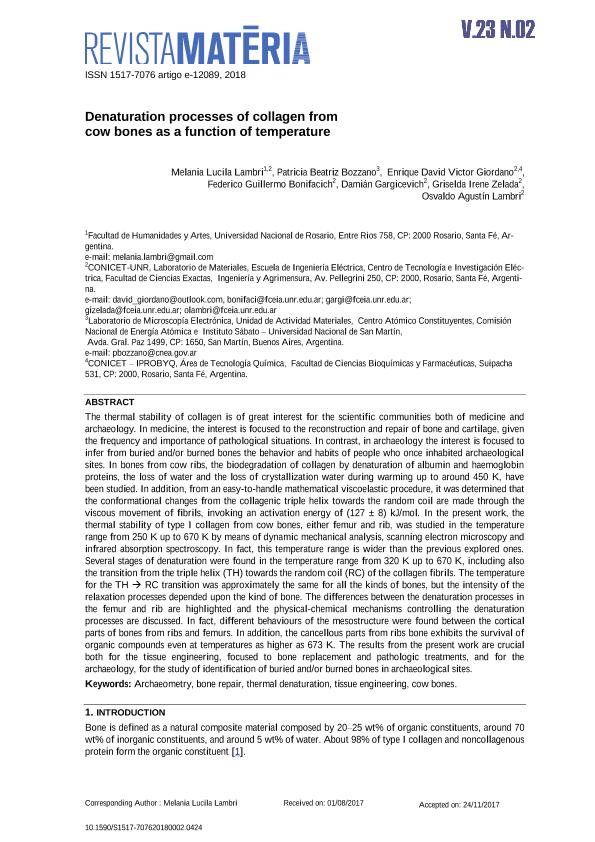Mostrar el registro sencillo del ítem
dc.contributor.author
Lambri, Melania Lucila

dc.contributor.author
Bozzano, Patricia Beatriz

dc.contributor.author
Giordano, Enrique David Victor

dc.contributor.author
Bonifacich, Federico Guillermo

dc.contributor.author
Gargicevich, Damian

dc.contributor.author
Zelada, Griselda Irene

dc.contributor.author
Lambri, Osvaldo Agustin F.

dc.date.available
2019-12-20T21:16:02Z
dc.date.issued
2018-07
dc.identifier.citation
Lambri, Melania Lucila; Bozzano, Patricia Beatriz; Giordano, Enrique David Victor; Bonifacich, Federico Guillermo; Gargicevich, Damian; et al.; Denaturation processes of collagen from cow bones as a function of temperature; Universidade Federal do Rio de Janeiro; Matéria; 23; 2; 7-2018; 1-11
dc.identifier.issn
1517-7076
dc.identifier.uri
http://hdl.handle.net/11336/92690
dc.description.abstract
The thermal stability of collagen is of great interest for the scientific communities both of medicine and archaeology. In medicine, the interest is focused to the reconstruction and repair of bone and cartilage, given the frequency and importance of pathological situations. In contrast, in archaeology the interest is focused to infer from buried and/or burned bones the behavior and habits of people who once inhabited archaeological sites. In bones from cow ribs, the biodegradation of collagen by denaturation of albumin and haemoglobin proteins, the loss of water and the loss of crystallization water during warming up to around 450 K, have been studied. In addition, from an easy-to-handle mathematical viscoelastic procedure, it was determined that the conformational changes from the collagenic triple helix towards the random coil are made through the viscous movement of fibrils, invoking an activation energy of (127 ± 8) kJ/mol. In the present work, the thermal stability of type I collagen from cow bones, either femur and rib, was studied in the temperature range from 250 K up to 670 K by means of dynamic mechanical analysis, scanning electron microscopy and infrared absorption spectroscopy. In fact, this temperature range is wider than the previous explored ones. Several stages of denaturation were found in the temperature range from 320 K up to 670 K, including also the transition from the triple helix (TH) towards the random coil (RC) of the collagen fibrils. The temperature for the TH → RC transition was approximately the same for all the kinds of bones, but the intensity of the relaxation processes depended upon the kind of bone. The differences between the denaturation processes in the femur and rib are highlighted and the physical-chemical mechanisms controlling the denaturation processes are discussed. In fact, different behaviours of the mesostructure were found between the cortical parts of bones from ribs and femurs. In addition, the cancellous parts from ribs bone exhibits the survival of organic compounds even at temperatures as higher as 673 K. The results from the present work are crucial both for the tissue engineering, focused to bone replacement and pathologic treatments, and for the archaeology, for the study of identification of buried and/or burned bones in archaeological sites.
dc.format
application/pdf
dc.language.iso
eng
dc.publisher
Universidade Federal do Rio de Janeiro

dc.rights
info:eu-repo/semantics/openAccess
dc.rights.uri
https://creativecommons.org/licenses/by-nc-sa/2.5/ar/
dc.subject
ARCHAEOMETRY
dc.subject
BONE REPAIR
dc.subject
COW BONES
dc.subject
THERMAL DENATURATION
dc.subject
TISSUE ENGINEERING
dc.subject.classification
Compuestos

dc.subject.classification
Ingeniería de los Materiales

dc.subject.classification
INGENIERÍAS Y TECNOLOGÍAS

dc.title
Denaturation processes of collagen from cow bones as a function of temperature
dc.type
info:eu-repo/semantics/article
dc.type
info:ar-repo/semantics/artículo
dc.type
info:eu-repo/semantics/publishedVersion
dc.date.updated
2019-10-15T17:27:38Z
dc.journal.volume
23
dc.journal.number
2
dc.journal.pagination
1-11
dc.journal.pais
Brasil

dc.description.fil
Fil: Lambri, Melania Lucila. Universidad Nacional de Rosario. Facultad de Ciencias Exactas, Ingeniería y Agrimensura; Argentina. Consejo Nacional de Investigaciones Científicas y Técnicas; Argentina
dc.description.fil
Fil: Bozzano, Patricia Beatriz. Comisión Nacional de Energía Atómica; Argentina
dc.description.fil
Fil: Giordano, Enrique David Victor. Consejo Nacional de Investigaciones Científicas y Técnicas. Centro Científico Tecnológico Conicet - Rosario. Instituto de Procesos Biotecnológicos y Químicos Rosario. Universidad Nacional de Rosario. Facultad de Ciencias Bioquímicas y Farmacéuticas. Instituto de Procesos Biotecnológicos y Químicos Rosario; Argentina
dc.description.fil
Fil: Bonifacich, Federico Guillermo. Universidad Nacional de Rosario. Facultad de Ciencias Exactas, Ingeniería y Agrimensura; Argentina. Consejo Nacional de Investigaciones Científicas y Técnicas; Argentina
dc.description.fil
Fil: Gargicevich, Damian. Universidad Nacional de Rosario. Facultad de Ciencias Exactas, Ingeniería y Agrimensura; Argentina. Consejo Nacional de Investigaciones Científicas y Técnicas; Argentina
dc.description.fil
Fil: Zelada, Griselda Irene. Universidad Nacional de Rosario. Facultad de Ciencias Exactas, Ingeniería y Agrimensura; Argentina
dc.description.fil
Fil: Lambri, Osvaldo Agustin F.. Universidad Nacional de Rosario; Argentina. Consejo Nacional de Investigaciones Científicas y Técnicas; Argentina
dc.journal.title
Matéria

dc.relation.alternativeid
info:eu-repo/semantics/altIdentifier/url/http://ref.scielo.org/4qt3j5
dc.relation.alternativeid
info:eu-repo/semantics/altIdentifier/doi/http://dx.doi.org/10.1590/S1517-707620180002.0424
Archivos asociados
